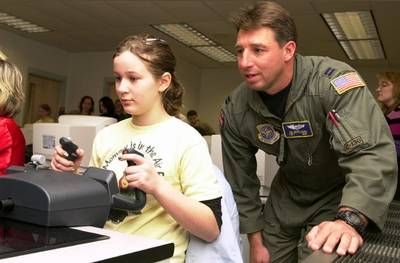West Virginia ANG Takes Cockpit To Classroom
On her 11th birthday, Catherine Newcome gripped the yoke of a
Cessna airplane and learned a lot about flying. She crashed the
first time she tried to land, but quickly regained her composure,
paid attention to her coach from the West Virginia Air National
Guard, took off and landed safely on her second try. And she did it
without leaving the safety of her classroom (below).

The program is called Starbase, and Catherine and her two dozen
fifth-grade classmates from the Eagle Intermediate School in
Martinsburg (WV) had just completed the first monthlong Starbase
Academy.
Two of the Martinsburg wing's C-130 Hercules pilots, Capts.
Kelly Wight and Jon McCullough, helped the youngsters get a feel
for flying the computer simulators. They monitored the "six-pack,"
just as they would in a real cockpit.
This Is A Long-Distance Call...
National Guard and NASA officials observed the pupils from
several locations thanks to the Guard's two-way television system
that it uses for distance learning programs.
Retired Navy pilot Pete Thomas taught the class from NASA's
Langley Research Center in Hampton, Va. He told the pupils that
aviators wear flight suits to protect them from flash fires and
that most people in aviation go to college.
"I've always been interested in the unknown, and I like the
exacting nature of flying. Hey, flying's a blast," Thomas told the
attentive class.
Taking The Risk Out Of At-Risk
"These are all at-risk kids," explained Joe Padilla who oversees
the Starbase program for the National Guard Bureau. "You want them
to think they've done something more than sit at an arcade game.
You want them to think that they can become a pilot, too."
 They are at risk, it was explained, because they
live in a rural part of the country that may not have the
educational resources of a big-city school system. They are also at
risk because of their age.
They are at risk, it was explained, because they
live in a rural part of the country that may not have the
educational resources of a big-city school system. They are also at
risk because of their age.
"Fifth-graders, kids who are 10 or 11 years old, are the most
impressionable. It's the beginning of their peer pressure years,"
explained Evonne DeNome, a former elementary teacher who is deputy
director of the new Starbase program in Martinsburg.
"This is the best time to start stressing the dangers of drugs,"
she added. "Our philosophy is to get them interested in something
else, such as math, science and technology."
The academy's motto, in the form of a mathematical equation,
states "Dreams + Action = Reality."
"It's fun, and it's challenging," Catherine said. "It's good for
kids to be able to do things that we don't get to do in
school."
That is what Starbase instructors have been striving to do for
pupils since the National Guard began sponsoring the academies in
1993. So far, Padilla said, 30 academies have been established in
23 states and territories, and approximately 1,000 young people
complete the four- or five-week programs every year. That is 30,000
young people who National Guard officials believe they are
helping.
 ANN's Daily Aero-Linx (05.02.24)
ANN's Daily Aero-Linx (05.02.24) ANN's Daily Aero-Term (05.02.24): Touchdown Zone Lighting
ANN's Daily Aero-Term (05.02.24): Touchdown Zone Lighting Aero-News: Quote of the Day (05.02.24)
Aero-News: Quote of the Day (05.02.24) ANN FAQ: Contributing To Aero-TV
ANN FAQ: Contributing To Aero-TV NTSB Final Report: Cirrus Design Corp SR20
NTSB Final Report: Cirrus Design Corp SR20




